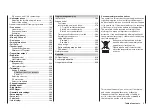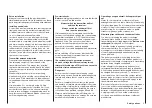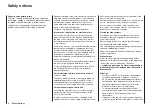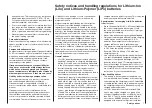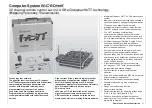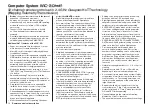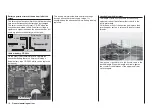
8
Safety notices
Discharging below 2.5 V per cell damages cells
•
permanently and is therefore to be avoided
absolutely. The
mc-20
HoTT transmitter switches
itself off when its power supply voltage reaches its
lower limit of 3.3 V. Short circuit conditions are to be
avoided absolutely. Permanent short circuits lead
to destruction of the battery, high temperatures and
perhaps even self-ignition may follow.
During discharge, battery temperature must not
•
rise, in any case, to over +70 °C. Otherwise,
better cooling or a lower rate of discharge must
be introduced. The temperature can easily be
checked with the infrared thermometer, order no.
1963
. The battery must never be discharged via
the transmitter's charging socket. This socket is
not suitable for this purpose.
Other handling notices
Never short-circuit the battery. A short-circuit
•
allows very high current to fl ow and this heats up
the cells. This will lead to loss of electrolyte, the
production of gases and perhaps even explosions.
In the vicinity of, or while handling,
Graupner
LiIo-/LiPo batteries, avoid electrically conducting
surfaces because of the danger of creating a
short-circuit condition.
Handling connectors:
•
These connectors are not as robust as for other
batteries. This applies particularly to the plus pole
connector. The connections can easily be broken
off. Due to thermal transfer, the connector tabs
may not be soldered directly.
Cell connection:
•
Direct soldering on battery cells is not permitted.
The heat of direct soldering can damage battery
components, such as separator or isolator.
Battery connections should only be made by
industrial spot welding. A professional repair made
by the manufacturer or distributor is necessary to
replace missing or torn-off cables.
Replacing individual battery cells:
•
The replacement of battery cells may only be
made by the manufacturer or distributor and never
by the user himself.
Damaged cell usage:
•
Damaged cells may never be used or returned to
service.
Characteristics of damaged cells include:
•
damaged housing packing, deformed battery cells,
electrolyte or leaking electrolyte. In these cases,
further use of the battery is not permissible.
Damaged or useless cells are hazardous waste
•
items and must be appropriately disposed.
General warning notices
Batteries must never be put in fi re or burned.
•
Battery cells must not be submerged in liquids,
•
such as water, seawater or beverages. Any contact
with liquids, of whatever nature, is to be avoided.
Individual battery cells and batteries are not toys
•
and must therefore not get into the hands of
children. Batteries/cells must be kept out of the
reach of children.
Batteries must not get into the vicinity of babies or
•
small children. If a battery is swallowed, immediately
go to a doctor or emergency medical facility.
Batteries must not be put in a microwave oven or
•
put under pressure. Smoke, fi re and more can be
the consequences.
Never dismantle a LiIo-/LiPo battery. Dismantling
•
a battery can cause internal short-circuits. Gas,
fi re, explosions and other problems can result.
The electrolyte and electrolytic vapors in LiIo-/LiPo
•
batteries are harmful. Absolutely avoid all direct
contact with electrolytes. If electrolytes come
into contact with skin, eyes or other body parts,
immediately wash out or rinse out with generous
amounts of fresh water then be sure to consult
"compensation" for voltage differences between
individual cells, by way of an otherwise typical
balancer plug connection, is not necessary.
Under these conditions
•
Graupner
LiIo-/LiPo
batteries can be charged with a maximum of 2C
(the value 1C corresponds to the cell capacity)
charging current. At a voltage of maximum 4.2 V
per cell and above, charging must continue a
constant voltage of 4.2 V per cell until charging
current drops below 0.1 … 0.2 A.
Charging voltage over 4.20 V per cell must be
•
avoided absolutely as the cell would otherwise be
permanently damage and could cause a fi re. In
order to prevent the over-charging of individual cells
in a pack, a cut-off voltage between 4.1 V … 4.15 V
per cell should be set to increase service life.
Never attempt to charge battery cells with the
•
wrong polarity. Abnormal chemical reactions take
place when batteries are charged with reversed
polarity and the battery will be useless. This can
cause breaks, smoke and fl ames.
The permissible temperature range for charging
•
and storing LiIo-/LiPo batteries is 0 … +50 °C.
Storage: LiIo-/LiPo cells should have a 10 … 20 %
•
charge capacity when stored. If cell voltage drops
below 3 V, then LiIo-/LiPo cells must absolutely
be recharged to a capacity of 10 … 20 % of full
capacity. Otherwise, further deep-discharging of
the battery will make it useless during storage in a
discharged state.
Special notices for discharging LiIo-/LiPo
batteries from
Graupner
A continuous current rate of about 1C does not
•
represent a major problem for
Graupner
LiIo-/LiPo
batteries. For larger currents, please follow the
catalog specifi cations. In any case, observe the
maximum current rating for the connector system,
see maximum discharge current on the battery.
Summary of Contents for 32032
Page 1: ...33020 mc 20HoTT 2 en Programming Manual o Pro Pro mc 20 mc 20...
Page 15: ...15 For your notes...
Page 21: ......
Page 27: ...27 For your notes...
Page 41: ...41 For your notes...
Page 53: ...53 For your notes...
Page 59: ...59 For your notes...
Page 63: ...63 For your notes...
Page 93: ...93 For your notes...
Page 97: ...97 For your notes...
Page 141: ...141 How is a ight phase programmed...
Page 145: ...145 For your notes...
Page 155: ...155 For your notes...
Page 175: ...175 For your notes...
Page 203: ...203 For your notes...
Page 219: ...219 For your notes...
Page 253: ...253 For your notes...
Page 283: ...283 For your notes...
Page 321: ...321 For your notes...
Page 322: ...322 For your notes...
Page 323: ...323 For your notes...



